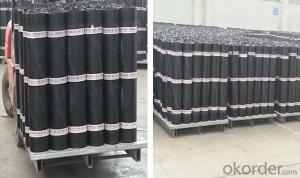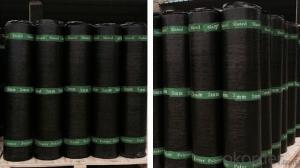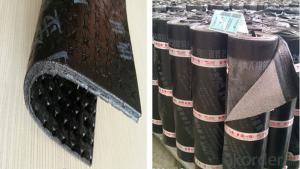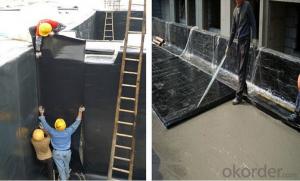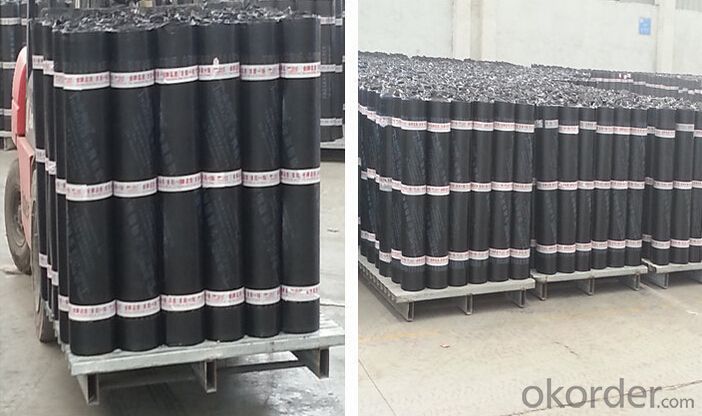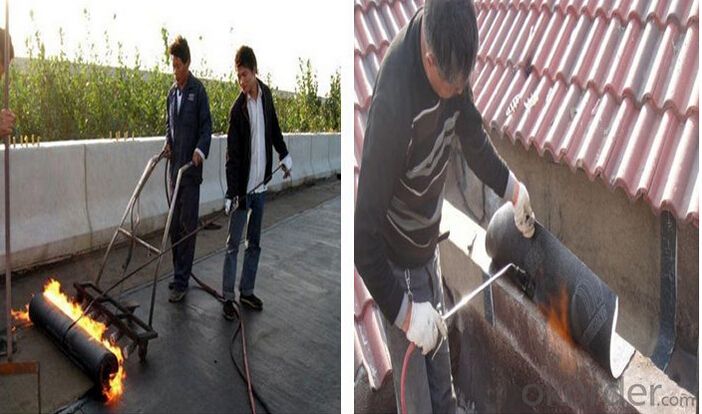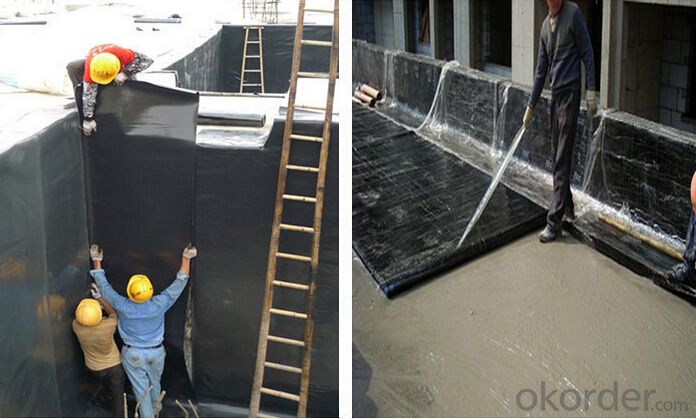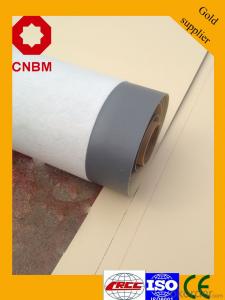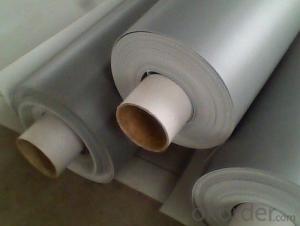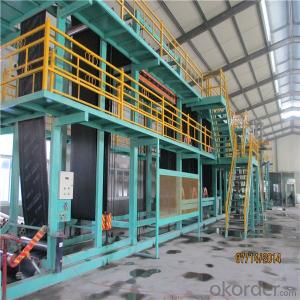SBS Bitumen Polyester Waterstoping Membrane
- Loading Port:
- Shanghai
- Payment Terms:
- TT OR LC
- Min Order Qty:
- 1000 m²
- Supply Capability:
- 200000 m²/month
OKorder Service Pledge
OKorder Financial Service
You Might Also Like
CE approved waterproof membrane price , self adhesive textured roll sbs waterproof membrane
product description:
CE approved waterproof membrane price , self adhesive textured roll sbs waterproof membrane take the “Skin” type waterproof thought, according to the features of construction site, on the basis of width elastomeric modified bitumen waterproofing membrane, combining with features of wet-application self-adhesive membrane, use advanced equipment to produce 2 meters width that WP-SBS wet-application width elastomeric modified bitumen waterproofing membrane (Hereinafter referred to: WP-SBS membrane).WP-SBS is made of bitumen modified with Styrene-Butadiene- Styrene (SBS)as dipping and painting. Its upper surface covers PE membrane and color sand or schist, and lower surface is made of isolation material. Products correspond to the national standards GB18242-2008(elastomeric modified bitumen waterproofing membrane), paste by cement or cement mortar, and construct on the wet base, achieving tight and full adhesion with substrates, eliminating fluid-channeling layer, all above contribute to making a reliable “Skin” type waterproof system, which is a breakthrough innovation in ordinary modified bitumen membrane.
Technical parameter
| Item | Specifications | ||||||||
| Geotextile Unit Weight (g/m²) | 300 | 500 | 600 | 700 | 800 | 900 | 1000 | 1100 | |
| Geomembrane Thickness (mm) | 0.25-0.35 | 0.30-0.50 | |||||||
| Nominal Fracture Strength (KN/m) | 2.50 | 7.50 | 10 | 12 | 14 | 16 | 18 | 20 | |
| Breaking Strength (KN/m,≥,LD/TD) | 2.50 | 7.50 | 10 | 12 | 14 | 16 | 18 | 20 | |
| Standard Intensity Corresponding Elongation Rate (%) | 30~100 | ||||||||
| CBR Burst Strength (KN,≥) | 0.70 | 1.50 | 1.90 | 2.20 | 2.50 | 2.80 | 3.00 | 3.20 | |
| Longitudinal Tear Strength (KN,≥) | 0.05 | 0.25 | 0.32 | 0.40 | 0.48 | 0.56 | 0.62 | 0.70 | |
| Hydrostatic Pressve (Mpa) | See List Below | ||||||||
| Peel Strength (N/cm,≥) | 6 | ||||||||
| Vertical Permeability Coefficient (cm/s) | According to design or contract mentioned. | ||||||||
| Width Variation (%) | -1.00 | ||||||||
| Item | Geomembrane Thickness (mm) | ||||||||
| 0.20 | 0.30 | 0.40 | 0.50 | 0.60 | 0.70 | 0.80 | 1.00 | ||
| Hydrostatic Pressve (Mpa) | One geotextiles with one geomembrane | 0.40 | 0.50 | 0.60 | 0.80 | 1.00 | 1.20 | 1.40 | 1.60 |
| Two geotextiles with one geomembrane | 0.50 | 0.60 | 0.80 | 1.00 | 1.20 | 1.40 | 1.60 | 1.80 | |
Characteristic
1.Good impermeability
2.Possess good tensile strength, elongation and size stability which could be well suited the substrate distortion and crack.
3.Good performance in anti-strength, anti-resistance , anti-erosion, anti-mildew, anti-weathering
4.SBS modified bitumen membrane is specially being applied in the cold area with low temperature, while APP modified bitumen membrane is applied in the area with high temperature.
5.Convenient installation
Applicable scope:
It is widely used for civil building roofing, underground, bridge, parking, pool, tunnel in the line of waterproofing and dampproofing, especially for the building under high temperature.
Application method:
1.Make sure the roof deck smooth ,clean and dry(Moisture<9%),then apply the surface of roof deck homogeneously with a kind bitumen paint till dry to start application.
2.There are two methods in application:
One way is by heating and melting method---Heat the polyethylene film of the membrane and roof deck surface by heating and melting method to be nearly melted (not flowing),then install the membrane fully bonded to the roof deck with overlaps of 5-10cm.
The other way is by cold adhesive method---Pour the cold adhesive homogeneously on the roof deck then roll the membrane to install it to be fully sticked to roof deck.
By heating and melting method and by cold adhesive can be used in alternation in application as requested.
3.After application ,a full serious inspection is required to make sure no air bubble ,no fold,no falling away etc to guarantee the waterproof life.
Our Services
1.If you need some advises for the waterproof construction, we have the best engineer to serve you.
2.We send the free samples to you by freight collect.
3.We will guarantee the quality and the competitive price.
4.We will give you the best packaging and safe shipping.
5.If any problem, we will always be right here waiting for you.
Product usage of pe compound waterproof membrane
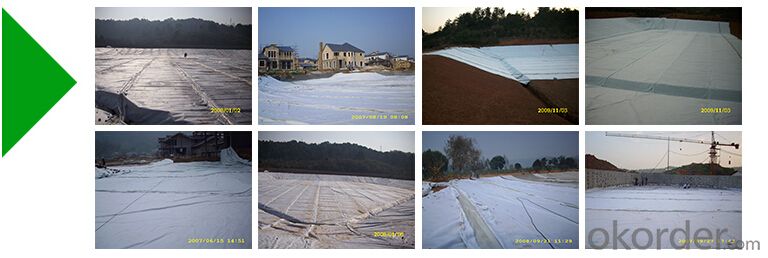
The products are widely used in projects of compound geomembrane impervious
Product line&test
♦Product line
From raw materials to finished products, every process is tested and controlled professionally and seriously by our professional machines and person.

Professional test machines ensure the products qualified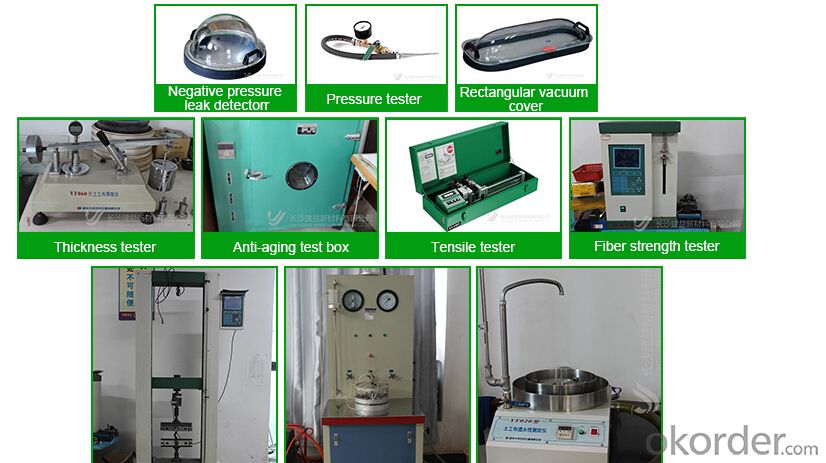 roduct certifications
roduct certifications
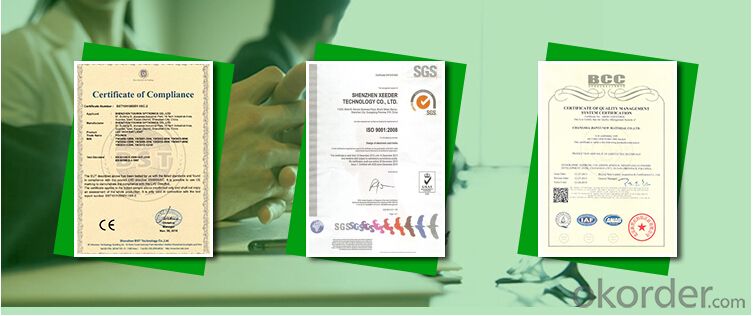
Inquiry Note
How to send an effective inquiry for saving your time?
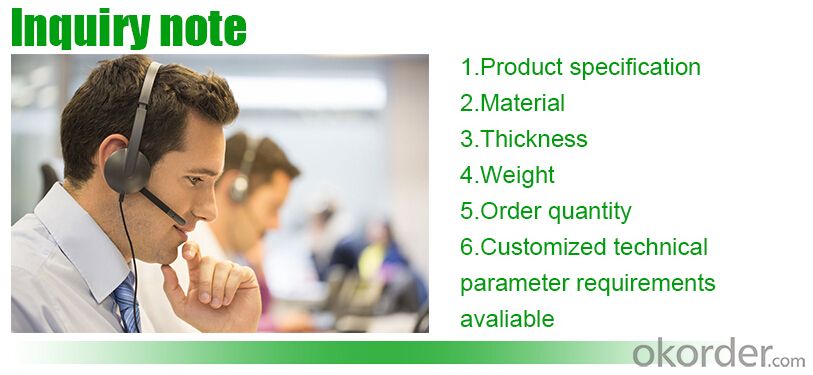

Packaging & Shipping

| Packing | Woven bag/PE bag packing or as customer request |
| Shipping | FOB Changsha,customized shipping terms and oppointed port accepted |
Why choose us ?
We have 20 years manufacturer experience
10000-30000 square meter factory size,more than 10 production lines
We will be your best partner,provide high quality products with CE,ISO,SGS
approved in competitive prive,sincerely hope to make a win-win cooperation with you.

FAQ

- Q: Are waterproofing membranes suitable for tunnels?
- Yes, waterproofing membranes are suitable for tunnels. They provide an effective barrier against water infiltration and can help prevent water damage and deterioration of the tunnel structure.
- Q: How does a waterproofing membrane withstand freeze-thaw cycles?
- To endure freeze-thaw cycles, a waterproofing membrane is constructed using materials that resist temperature shifts and water infiltration. Typically, these membranes consist of robust polymers like polyurethane, polyethylene, or PVC, which have low water permeability and can withstand the expansion and contraction caused by freezing and thawing. Freeze-thaw cycles allow water to seep into small cracks and pores within a structure. As the water freezes, it expands, exerting pressure on the surrounding materials. This pressure can widen cracks and weaken the structure, resulting in water leakage and potential damage. However, a waterproofing membrane acts as a barrier, preventing water from infiltrating the structure and minimizing the risk of freeze-thaw damage. The membrane is applied to the exterior surface of the structure, forming a continuous and seamless layer that prohibits water passage. It adheres securely to the surface and possesses flexibility to accommodate dimensional changes caused by temperature fluctuations. Additionally, waterproofing membranes are often reinforced with fabrics or meshes to enhance their strength and stability. These reinforcements provide further protection against damage during freeze-thaw cycles, ensuring the long-term effectiveness of the membrane. In conclusion, a waterproofing membrane endures freeze-thaw cycles by impeding water infiltration and withstanding the expansion and contraction caused by freezing and thawing. Its composition, including durable polymers and reinforcements, establishes it as a dependable barrier against water penetration, reducing the likelihood of structural damage and upholding the integrity of the protected surface.
- Q: Can a waterproofing membrane be used for both interior and exterior applications?
- Indeed, a waterproofing membrane holds the capability to be utilized for both interior and exterior purposes. The primary purpose of waterproofing membranes revolves around averting the intrusion of water and safeguarding against moisture-induced harm. These membranes are extensively employed in basements, bathrooms, and various indoor areas to obstruct the infiltration of water and the subsequent development of dampness. Moreover, the application of waterproofing membranes on the external surface of edifices offers defense against rain, snow, and other extrinsic factors. By employing a waterproofing membrane for both interior and exterior applications, one can ensure a comprehensive safeguard against water-related destruction, ultimately preserving the structural integrity of their property.
- Q: Can waterproofing membranes be used on outdoor decks?
- Yes, waterproofing membranes can be used on outdoor decks. They provide an effective barrier against water and moisture, protecting the deck's structure and preventing damage from weather elements. Waterproofing membranes help to extend the lifespan of the deck and maintain its aesthetic appeal.
- Q: Can a waterproofing membrane be used in conjunction with insulation materials?
- Yes, a waterproofing membrane can be used in conjunction with insulation materials. In fact, it is often recommended to use both together in order to provide a comprehensive solution for protecting buildings from moisture and enhancing energy efficiency. The waterproofing membrane acts as a barrier to prevent water infiltration, while insulation materials help to regulate temperature and reduce heat loss or gain. By combining these two components, the building envelope can be effectively protected from water damage and insulated to maintain a comfortable indoor environment. It is important to ensure that the waterproofing membrane is properly installed and compatible with the insulation materials to achieve optimal performance and longevity.
- Q: Does a waterproofing membrane require any curing time?
- Indeed, a curing time is typically necessary for a waterproofing membrane to fully bond and establish a robust, impermeable barrier. The duration of this curing period can differ based on the type of membrane employed and the instructions provided by the manufacturer. While the membrane is undergoing the curing process, precautions should be taken to shield it from foot traffic, water exposure, and any other potential sources of harm. Adhering to the recommended curing time is crucial in guaranteeing the membrane's effectiveness and durability.
- Q: Can a waterproofing membrane be used for tunnels and underground structures?
- Yes, a waterproofing membrane can definitely be used for tunnels and underground structures. These membranes are specifically designed to provide a protective barrier against water infiltration, preventing moisture from penetrating the structure and causing damage. They are highly effective in ensuring the long-term durability and structural integrity of tunnels and underground constructions.
- Q: Can a waterproofing membrane be used in foundations?
- Foundations can benefit from the use of a waterproofing membrane. Installing such a membrane is often recommended to prevent water infiltration and protect the structure from potential damage. This barrier is typically applied to the exterior walls of the foundation, effectively blocking water penetration. By keeping the foundation dry, it safeguards against cracks and leaks caused by hydrostatic pressure. Moreover, a waterproofing membrane helps prevent moisture buildup, mold growth, and other water damage-related issues. Overall, incorporating a waterproofing membrane in foundations is a dependable and effective approach to ensure the long-lasting stability and durability of a building.
- Q: Does a waterproofing membrane require any special precautions during installation?
- Yes, a waterproofing membrane does require some special precautions during installation. Here are a few key considerations: 1. Surface Preparation: Before installing the waterproofing membrane, it is crucial to ensure that the surface is clean, dry, and free from any debris or loose particles. This may require thorough cleaning or even repairing any existing cracks or damages on the surface. 2. Adhesive Compatibility: It is important to use the appropriate adhesive or sealant that is compatible with the specific type of waterproofing membrane being installed. Using an incompatible adhesive can lead to poor adhesion, compromising the effectiveness of the waterproofing system. 3. Proper Application Technique: The membrane should be installed according to the manufacturer's guidelines, which may include specific instructions on temperature, humidity, and application technique. It is crucial to follow these instructions carefully to ensure proper adhesion and performance. 4. Seam and Joint Sealing: Paying attention to the seams and joints is critical as these areas are more prone to water penetration. Special care should be taken to properly seal and reinforce these areas using the recommended sealants or tapes provided by the manufacturer. 5. Quality Control: Regular quality control checks should be carried out during installation to ensure that the membrane is being installed correctly and any potential issues or defects are identified and addressed promptly. Overall, following the manufacturer's instructions and paying attention to the specific details of the installation process will help ensure that the waterproofing membrane is installed correctly and provides effective protection against water intrusion.
- Q: Can a waterproofing membrane be certified or approved by industry organizations?
- Indeed, industry organizations have the ability to certify or approve waterproofing membranes. There exist various industry organizations and standards bodies that assess and endorse building materials and products, including waterproofing membranes. These certifications or approvals serve as a guarantee that the membrane satisfies specific quality and performance standards established by the industry. Well-known industry organizations such as the International Organization for Standardization (ISO), Underwriters Laboratories (UL), and the American Society for Testing and Materials (ASTM) often grant certifications or approvals for waterproofing membranes. These certifications involve thorough testing and evaluation of the membrane's physical properties, such as its resistance to water penetration, durability, and compatibility with other construction materials. Certifications or approvals from industry organizations provide reassurance to consumers, architects, contractors, and building owners regarding the waterproofing membrane's thorough testing and alignment with recognized standards for quality and performance. They also facilitate compliance with building codes and may be obligatory for specific projects. It is always prudent to seek out waterproofing membranes that have received certification or approval from reputable industry organizations to ensure that you are utilizing a dependable and efficient product for your waterproofing requirements.
Send your message to us
SBS Bitumen Polyester Waterstoping Membrane
- Loading Port:
- Shanghai
- Payment Terms:
- TT OR LC
- Min Order Qty:
- 1000 m²
- Supply Capability:
- 200000 m²/month
OKorder Service Pledge
OKorder Financial Service
Similar products
Hot products
Hot Searches
Related keywords
